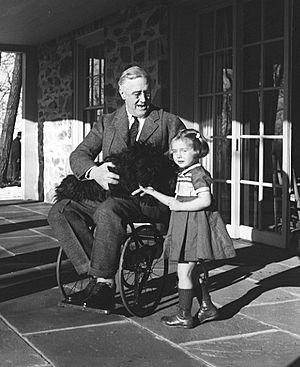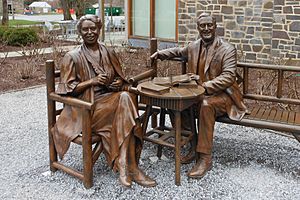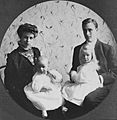Franklin D. Roosevelt facts for kids
Quick facts for kids
Franklin D. Roosevelt
|
|
|---|---|
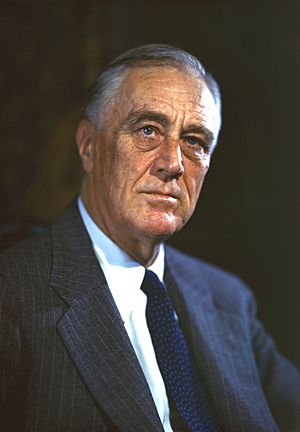
Picture by Leon Perskie, 1944
|
|
| 32nd President of the United States | |
| In office March 4, 1933 – April 12, 1945 |
|
| Vice President |
|
| Preceded by | Herbert Hoover |
| Succeeded by | Harry S. Truman |
| 44th Governor of New York | |
| In office January 1, 1929 – December 31, 1932 |
|
| Lieutenant | Herbert H. Lehman |
| Preceded by | Al Smith |
| Succeeded by | Herbert H. Lehman |
| Assistant Secretary of the Navy | |
| In office March 17, 1913 – August 26, 1920 |
|
| President | Woodrow Wilson |
| Preceded by | Beekman Winthrop |
| Succeeded by | Gordon Woodbury |
| Member of the New York Senate from the 26th district |
|
| In office January 1, 1911 – March 17, 1913 |
|
| Preceded by | John F. Schlosser |
| Succeeded by | James E. Towner |
| Personal details | |
| Born |
Franklin Delano Roosevelt
January 30, 1882 Hyde Park, New York, U.S. |
| Died | April 12, 1945 (aged 63) Warm Springs, Georgia, U.S. |
| Cause of death | Cerebral hemorrhage |
| Resting place | Springwood Estate Hyde Park, New York, U.S. |
| Political party | Democratic |
| Spouse | |
| Children | 6 |
| Parents |
|
| Relatives |
|
| Education | Harvard University (BA) Columbia University (JD) (posthumous, 2008) |
| Signature | |
Franklin Delano Roosevelt (January 30, 1882 - April 12, 1945) was the 32nd President of the United States. He served as president from 1933 until his death in 1945. He was president for 12 years, which is the longest time anyone has held the office. After he died, a new rule was made called the 22nd Amendment. It limits how many terms a president can serve. Before becoming president, he was Governor of New York from 1929 to 1932. He also served as Assistant United States Secretary of the Navy from 1913 to 1920. Earlier, he was a state senator from New York.
Contents
Family and Early Life
thumb|Formal portrait of Franklin D. Roosevelt at age 18, in Groton, Massachusetts. Franklin Delano Roosevelt was born on January 30, 1882. His birthplace was Hyde Park, a town in the Hudson Valley in New York. His parents were James Roosevelt and Sara Delano. Both of his parents came from wealthy, old New York families. Franklin was their only child together.
When Franklin was five years old, his father took him to meet President Grover Cleveland. The president told him, "My little man, I am making a strange wish for you. It is that you may never be President of the United States." However, Roosevelt went on to become the longest-serving president in American history. Franklin was also a distant cousin of another U.S. President, Theodore Roosevelt. He married his fifth cousin, Eleanor Roosevelt. She later became his wife and an important partner in his political career.
Early Political Career
Roosevelt started his political journey as the Assistant to the United States Secretary of the Navy. He served under President Woodrow Wilson. In 1920, he was chosen as the candidate for vice president. He ran alongside James M. Cox, but they lost the election.
In 1921, Roosevelt became very sick with poliomyelitis. This disease can cause paralysis. He was never able to walk again on his own. Despite this, Roosevelt stayed physically active and enjoyed swimming. He became a strong supporter of medical research for illnesses that cause disabilities. He tried to keep his illness private, fearing that people might treat him differently.
His disability did not stop his political career. Roosevelt was elected Governor of New York in 1928. His wife, Eleanor Roosevelt, played a big role in his success. She traveled and met many people when he could not. She became known as his "eyes and ears," listening to the concerns of ordinary people and sharing them with Roosevelt.
Presidency and the Great Depression
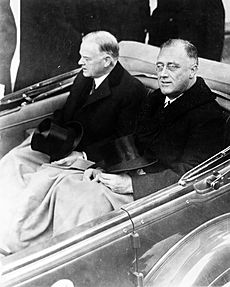
Roosevelt won the election against the current president, Herbert Hoover, and became president in early 1933. At this time, the United States was in the middle of the Great Depression. This was a very difficult time when many people lost their jobs and money.
To help the country, Roosevelt started many programs called the New Deal. These programs aimed to create jobs and help people. The New Deal gave people work building roads, bridges, dams, parks, and schools. It also created Social Security, which provides financial help to older people and those with disabilities. The New Deal also made banks safer and gave direct aid to people who needed it. Because of these popular programs, Roosevelt was re-elected in 1936. He continued to expand the New Deal. The United States did not fully recover from the Great Depression until it entered World War II.
In 1939, Roosevelt made history by becoming the first U.S. president to appear on television. He was elected for a third term in 1940. During this time, he began to help the Allies who were fighting in World War II. He sent them weapons and money through a program called Lend-Lease. The United States was still officially neutral in the war at this point.
Leading During World War II
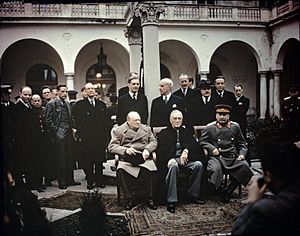
On December 7, 1941, Japan attacked the Pearl Harbor military base in Hawaii. The next day, December 8, the United States Congress declared war on Japan. This happened shortly after Roosevelt gave his famous Infamy Speech. After the U.S. declared war, Japan's allies, Germany and Italy, also declared war on the United States. This brought the U.S. fully into World War II.
During the war, Roosevelt signed an order that sent Japanese Americans to internment camps. This meant they were forced to leave their homes and live in special camps. This was a controversial decision.
Roosevelt died on April 12, 1945, while still president. Vice President Harry S. Truman became the new president. World War II continued for almost four more months, but the Allies were already close to winning. Historians often see Roosevelt as one of the best U.S. presidents. This is because he led the country through the challenges of the Great Depression and World War II.
Death and Memorials
On April 12, 1945, Roosevelt was in Warm Springs, Georgia. He was sitting for a portrait when he said, "I have a terrific headache." He then became unconscious and was carried to his bedroom. Doctors said he had a massive brain hemorrhage. At 3:35 p.m. that day, Roosevelt died at the age of 63.
Roosevelt's home in Hyde Park is now a National Historic Site. It is also home to his Presidential library. In Washington D.C., there are two memorials dedicated to him. The largest is the Franklin Delano Roosevelt Memorial, which is about 7.5 acres. It is located near the Jefferson Memorial. A smaller memorial, a block of marble, was put in front of the National Archives building in 1965. Roosevelt himself had suggested this simpler memorial.
Roosevelt's work with the March of Dimes is why he is honored on the American dime coin. He has also appeared on several U.S. Postage stamps.
Related pages
Images for kids
-
Roosevelt supported Governor Woodrow Wilson in the 1912 presidential election.
-
Theodore Roosevelt was Franklin Roosevelt's distant cousin and an important influence on his career.
-
Gov. Roosevelt with his predecessor Al Smith, 1930
-
Roosevelt with Brazilian President Getúlio Vargas and other dignitaries in Brazil, 1936
-
The Roosevelts with King George VI and Queen Elizabeth, sailing from Washington, D.C., to Mount Vernon, Virginia, on the USS Potomac during the first U.S. visit of a reigning British monarch (June 9, 1939)
-
Roosevelt and Winston Churchill aboard HMS Prince of Wales for 1941 Atlantic Charter meeting
-
Official portrait of President Roosevelt by Frank O. Salisbury, c. 1947
-
Eleanor Roosevelt and Mary McLeod Bethune, a member of Roosevelt's Black Cabinet (a key advisory group on race relations)
See also
 In Spanish: Franklin D. Roosevelt para niños
In Spanish: Franklin D. Roosevelt para niños


